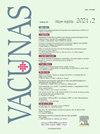COVID-19 story: Entry and immune response
Q3 Medicine
引用次数: 0
Abstract
Severe acute respiratory syndrome coronavirus 2 (SARS-CoV-2) is responsible for the pandemic of the coronavirus disease 2019 (COVID-19) that emerged in December 2019 in Wuhan city, China. Understanding the SARS-CoV-2 entry, invasion and infection mechanism is crucial for vaccine development. The immune system is divided into 2 parts: the innate immune system and the adaptive immune system, and they work in essential and powerful ways for SARS-CoV-2 managing and reducing COVID-19 infections. Spike proteins (S) of SARS-CoV-2 are a pivotal key during the viral invasion of the host cells. Cell surface receptors facilitate binding and then membrane fusion for virus endocytosis and causing infection. Host cells are covered with receptors for viral S proteins binding, such as the human angiotensin-converting enzyme 2 receptor. The innate immune responses initiate after viral antigen detection via a set of pathogen recognition receptors, including the Toll-like receptors (TLRs) family. TLRs are largely inducible in most body cell types. After SARS-CoV-2 antigen recognition, cellular sensors stimulate the production of interferons and inflammatory cytokines, which are crucial for controlling viral replication and dissemination. The cellular and humoral responses of the adaptive immune system antibody-producing B-cells, CD4 + T-cells to evoke the immune response, and CD8 + T-cells to kill infected cells. This review outlines the process of virus entry and detection by pattern recognition receptors and antiviral defence by both innate immunity and adaptive immunity for developing immunological memory that can help in vaccines and understanding the immune response to SARS-CoV-2.
COVID-19故事:进入和免疫反应
严重急性呼吸综合征冠状病毒2型(SARS-CoV-2)是2019年12月在中国武汉市出现的2019冠状病毒病(COVID-19)大流行的罪魁祸首。了解SARS-CoV-2的进入、侵袭和感染机制对疫苗开发至关重要。免疫系统分为两部分:先天免疫系统和适应性免疫系统,它们在SARS-CoV-2管理和减少COVID-19感染方面发挥着重要而有力的作用。SARS-CoV-2的刺突蛋白(Spike protein, S)是病毒入侵宿主细胞的关键。细胞表面受体促进结合,然后膜融合病毒内吞和引起感染。宿主细胞覆盖着与病毒S蛋白结合的受体,如人血管紧张素转换酶2受体。先天免疫反应通过一系列病原体识别受体,包括toll样受体(TLRs)家族,在病毒抗原检测后启动。tlr在大多数体细胞类型中都是可诱导的。在SARS-CoV-2抗原识别后,细胞传感器刺激干扰素和炎症细胞因子的产生,这对控制病毒复制和传播至关重要。适应性免疫系统的细胞和体液反应——产生抗体的b细胞、引起免疫反应的CD4 + t细胞和杀死感染细胞的CD8 + t细胞。本文概述了模式识别受体进入和检测病毒以及先天免疫和适应性免疫的抗病毒防御过程,以形成免疫记忆,有助于疫苗和理解对SARS-CoV-2的免疫反应。
本文章由计算机程序翻译,如有差异,请以英文原文为准。
求助全文
约1分钟内获得全文
求助全文
来源期刊

Vacunas
Medicine-Infectious Diseases
CiteScore
3.90
自引率
0.00%
发文量
138
审稿时长
62 days
期刊介绍:
Sin duda una de las mejores publicaciones para conocer los avances en el campo de las vacunaciones preventivas, tanto en el ámbito de la investigación básica como aplicada y en la evaluación de programas de vacunaciones. Su alta calidad y utilidad la ha llevado a estar indexada en los prestigiosos índices IME y SCOPUS.
 求助内容:
求助内容: 应助结果提醒方式:
应助结果提醒方式:


